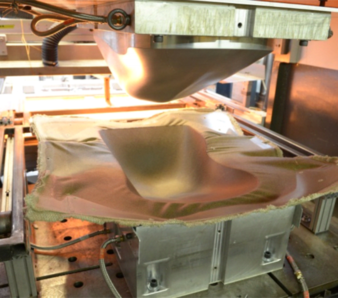24/08/2020 – Sustainable nonwovens — auf Deutsch lesen
Natural fibres in technical nonwovens – research results
Natural fibres and their use can make an important contribution to the fight against global warming.
Compliance with emission limits and the containment of the greenhouse effect are of central importance for today’s economy and society.
Natural fibres and their use can make an important contribution to the fight against global warming due to their neutral CO2 balance and the low energy expenditure for processing. Their use in technical textiles, especially with regard to composite materials, offers great potential, as the properties of natural fibres can be utilized very well in these areas. A particularly efficient and therefore inexpensive way of producing textile surfaces which can then be further processed into natural fibre reinforced plastics is the processing of a nonwoven.
Significant advantages of nature fibres
Especially with regard to natural fibres, there are some significant advantages. Natural fibres are always staple fibres of limited length, which is necessary for the production of nonwovens in the carding process. In addition, the natural fibres can be mixed directly with thermoplastic matrix material before and during the carding process, provided that these are also available as staple fibres. The mixed nonwovens produced in this way can then be pressed into finished composite components using the hot pressing process. During the last years, various research projects in the field of sustainable nonwovens have been carried out at the Institut für Textiltechnik of RWTH University, short ITA.
Research projects in the field of sustainable nonwovens
The NatureWins research project aimed at developing bio-based composites from 100 percent renewable raw materials. For implementation, thermoplastic biopolymers were combined with long natural fibres to form a sustainable composite material. The mechanical properties achieved in the manufactured components are comparable to materials frequently used in the automotive industry. As a functional demonstrator, a car seat was produced from the developed material [AiF15N].
In the EU project BioFibroCar a material for automotive interior parts was developed. Similar to the NatureWins Project, under the condition that only renewable and environmentally friendly biopolymers are used. Therefore, new functionalised yarns made of biopolymers were developed and produced. Furthermore, new compounds made of polylactide (PLA) with improved properties were developed for use in automotive interiors. Additives with antimicrobial effects as well as odour inhibiting additives were used. The properties of the produced PLA composite material were benchmarked against a comparable polyester material. Both the strength and the tensile strength of the PLA could be increased by 20 percent compared to the polyester. In addition, the modulus of elasticity was 150 percent higher, while achieving the same air permeability [EU15].
A different approach was pursued in the Cornet research project BioSRPC. Here too, sustainable and bio-based composites with fibre reinforcement were the target. The approach however was to develop a bio based polymer with self-reinforcement. Two types of PLA are needed to produce self-reinforced composites: one type with a low melting temperature to form the matrix and one type with high stiffness and a higher melting temperature for the reinforcing fibres. Besides nonwovens, various other textile surfaces were also created from the material. Suitcases and trays were produced as demonstration objects to show the capabilities of the material [AiF15B].
And within the System4Green project, a knowledge-based method has been developed, with the participation of ITA, to replace conventional components with materials from 100 percent renewable resources. The method was developed primarily for composite materials. Besides the substitution of conventional materials by renewable materials, the method can drastically reduce the development time of products made from renewable materials for manufacturers [AiF17].
Solutions for the use of natural fibres
Despite promising developments in the field of renewable raw materials, they are still not used to the extent that would be possible in principle. Fluctuations in the property profile make it more difficult to meet quality requirements. The fluctuations are due to different fibre types, growing areas, climatic conditions and growing years. Currently, the mechanical properties of natural fibre composites (NFC) components are usually determined by means of complex destructive component tests. Based on the results the component design is iteratively adapted to the requirements. This procedure represents a major hurdle for small and medium-sized enterprises (SMEs) in particular to enter the NFC market. One possible approach to solve this problem is to develop a model which allows the calculation of the realisable properties of components made from natural fibre composites. The model should be able to determine the properties of the resulting parts, based on the properties of the natural fibres used, which can be determined quickly and cheaply. As possible approach for the model that has to be developed, the calculation model according to Cox and Krenchel can be used as basis. Under certain conditions a strongly modified Cox-Krenchel model can be used for the calculation of tensile strength and the moduli of elasticity of NFC. The equation includes the length of the individual fibres in addition to the moduli of elasticity. This also takes into account the effective transmission of the shear forces in the component (Shear-Lag-Theory). In addition, Krenchel gives an extension of the Shear-Lag-Theory with which the fibre orientation can be included in the calculation. The equation can also be used to calculate the (tensile) strength of a component by replacing the moduli of elasticity with the (tensile) strengths. Studies have shown that sufficiently accurate results can be obtained. However, the material constants used are based on experimentally determined values and estimates using micrographs that are difficult to produce. The determination of these characteristic values must be repeated for each material combination and when the process parameters change [GHP00, MTL09].
For a simple applicability and thus broader use of such a model, it is necessary to extend the model in such a way that the realisable component properties of NFC components can be calculated with sufficient accuracy on the basis of easily determined material properties. In areas in which an investigation of the substitution of other materials by NFC has not been considered at all up to now, due to reasons like complex design, an assessment of the feasibility can easily be given with an application-friendly design tool. Since resource efficiency and recycling will play an increasingly important role in the design of new products in the coming years, it is very likely that the share of NFCs in the composite market will continue to increase.
Jonas Broening, ITA RWTH Aachen Universität
Sources:
[AiF15B] AiF CORNET Abschlussbericht BioSRPC, IGF-Vorhaben Nr. 90 EN: Entwicklung selbstverstärkender Verbundmaterialien aus biobasierten Rohstoffen – bio-srpc, Aachen 2015
[AiF15N] AiF CORNET Abschlussbericht NatureWins: Development of fully renewable thermoplastic bio-composites, Aachen 2015
[AiF17] AiF CORNET Abschlussbericht System4Green, IGF-Vorhaben Nr. 139EN: Methodology for development of products with renewable raw materials, Aachen 2017
[EU15] Abschlussbericht zum EU-Projekt BioFibroCar, Antragsnummer: 315479, Aachen 2015
[GHP00] Garkhail, SK.; Heijenrath, RWH.; Peijs, T.: Mechanical Properties of Natural-Fibre-Mat-Reinforced Thermoplastics based on Flax Fibres and Polypropylene Applied Composite Materials 7 (2000), H. 5/6, S. 351-372
[MTL09] Madsen, B.; Thygesen, A.; Lilholt, H.: Plant fibre composites–porosity and stiffness Composites Science and Technology 69 (2009), H. 6, S. 1057-1069





